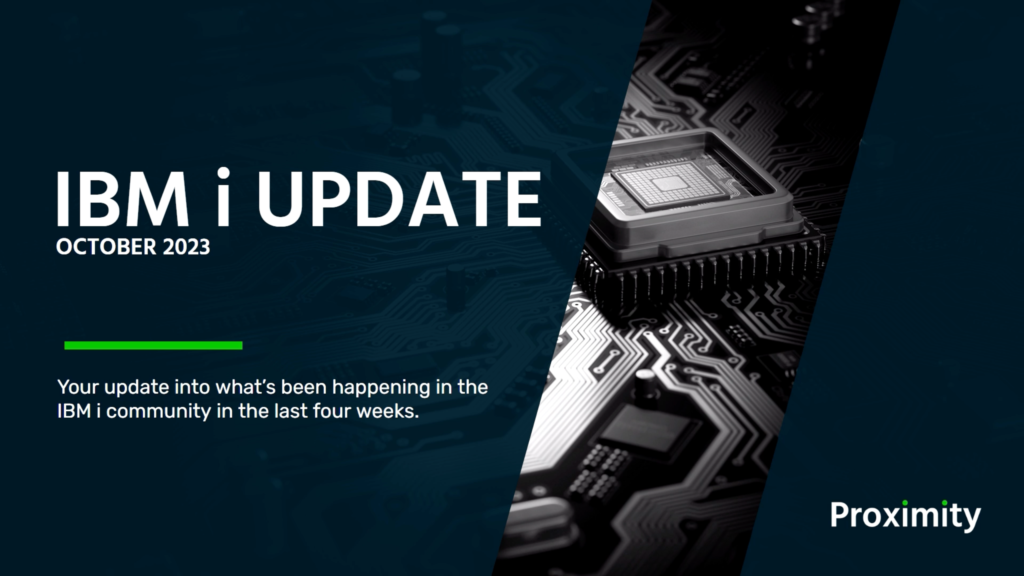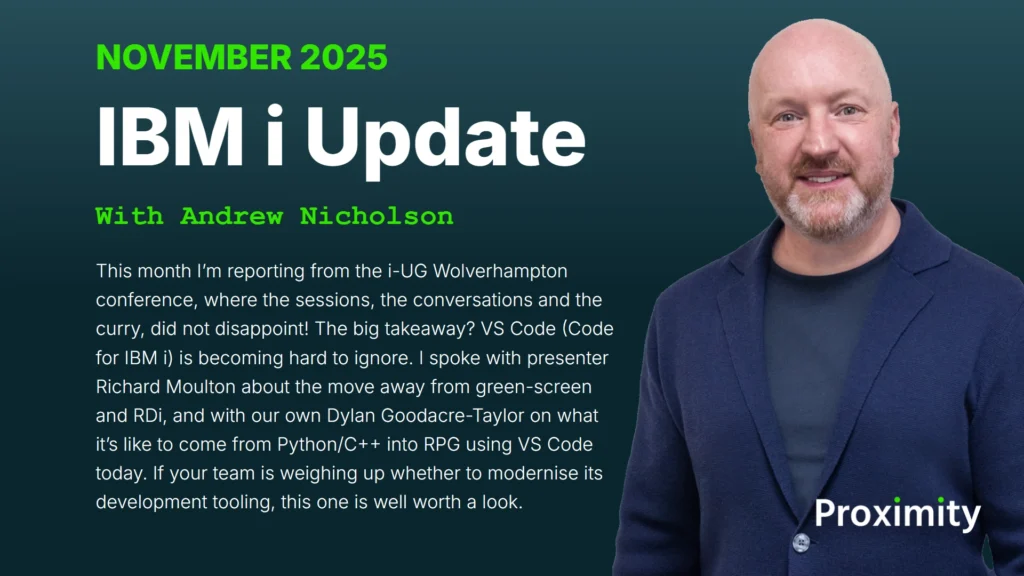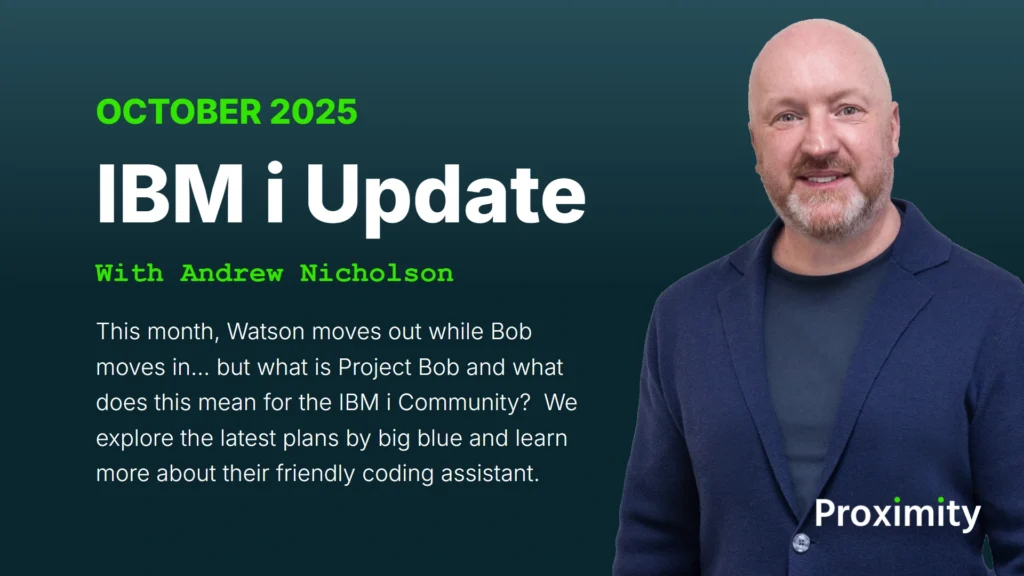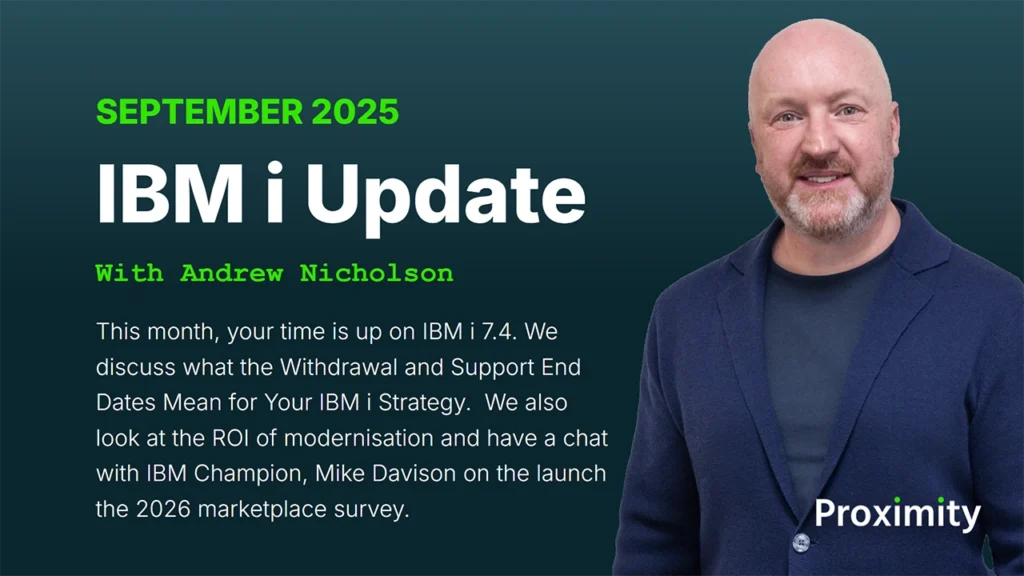Welcome to your #IBMi update, your monthly update into what’s been happening in the IBM i community, with Andy Nicholson from Proximity. You can watch the video below or read the full article underneath.
Watch the Video:
Full Article:
Culture before code, New IBM i releases and the rise of the Subscription Model
This month, we explore ‘culture before code’, The opening of the IBM i Marketplace Survey, Announcements of IBM i 7.5 TR3 & 7.4 TR9 and discuss the rise of the subscription model and if it’s right for your IBM I shop.
Culture Before Code
Now in late September, Andrew Clark of ARCAD wrote an article on how the first steps in DevOps isn’t in fact the tools, but culture change.
In this article, Andrew explains that DevOps starts before putting in the tooling such as git or Jenkins as the first step on the DevOps roadmap, for most companies, you should actually be looking at culture change…
Andrew explains that there are normally two camps in IBM i shops.
The IBM i people in one camp and then the non-IBM i people – usually running something like Windows and .Net, or Linux and Java. Now, in an ideal world, all we would need to do is bring both parties round the ‘IT campfire’ and sing ‘kumbaya’ from the same DevOps hymn sheet and all would be well.
The problem is that we often find is that the non-IBM i people are already comfortable and are metaphorically roasting their marshmallow with established DevOps processes in place. They don’t need to meet in the middle ‘thank you very much’. The IBM i camp too may have disparate systems that they use day to day. Both camps work independently, and rarely talk.
As a result, you often find that the two teams have code bases that do exactly the same thing – they’ve written the same functionality but in different languages. Obviously, this caused problems related to dual maintenance of a larger code base.
To mitigate these problems, we need to get both camps working together and discover problems and plan accordingly, early in the process. Andrew goes onto explain that for a lot of times, the IBM i is right platform on which to implement those functions due to the fact that IBM i does packed decimal arithmetic very well, and is a heavy transaction powerhouse.
Now the article goes on to discuss the next steps in DevOps and I recommend you go check it out. You can find the article here – https://www.itjungle.com/2023/09/25/the-first-step-in-devops-is-not-tools-but-culture-change/
But the crux of the argument that Andrew puts across very well is that setting the right DevOps culture within the business lays the foundations for successful delivery. Without solid foundations, your developments may falter and fail.
2024 IBM i Marketplace Survey
Moving on, the 2024 IBM i Marketplace Survey is OPEN. I do encourage you to complete the survey, it provides a great snapshot of what the IBM i community is doing and where it’s going… and perhaps more importantly, focuses minds and commitments from those who service who are to evolve the IBM i ecosystem for your requirement today and into the future.
IBM i Updates: IBM i 7.5 TR3 & 7.4 TR9
on the 10th October, Steve Will provided an update on technology refreshes for IBM i 7.4 and 7.5…
Details are available under the IBM’s support pages but to provide a little insight, on databases enhancements, systools have been enhanced to include AES 256 encryption, a much more powerful encryption scalar function than SQL. We have a new CLOB-based scalar function for encoding and decoding HTML for SQL-based RESTful services. In addition, there are new SQL-based functions that accomplish a variety of tasks and are replacements for CL commands and APIs across the operating system.
On navigator, we’ve a new ‘angular’ Java based GUI, new table filters, enhanced DNS Support and new IFS Functionality. The printing functionality has been bolstered and a new security feature added for tracking system values.
For HA and DR, IBM has a new job tracking features that will provide automated tracking for certain job queues; better visibility of jobs at the time of failure, and simpler resubmission of failed jobs during a recovery. There’s a new IASP history synchronisation function for HA environments and a new health centre guifor new view into products.
In SysTool IBM have added the The DUMP_PLAN_CACHE procedure has been added to find easier ways to automate interactions with the SQL plan cache. And a new command to show you all the journals that are participating in transactions, and it tells you where it’s at and the percentage rollback. They’ve also added a generate spreadsheet – a new scalar function for creating a spreadsheet; and SEND_EMAIL, another new scalar function for sending an email with an attachment from the IFS.
RDi gains several some minor tweaks too, to clean up the user interface and there’s a new VS Code plug-in developed by Liam Allan. In addition, IBM have improved support for RPG, CL, COBOL, and SQL within Git.
Finally, we have a new version of Access Client Solutions that brings new capabilities to the popular Run SQL Scripts, new “insert from example” options, and syntax compatibility with the latest SQL standard, among other capabilities.
Subscription Success: The Rise of the Subscription Model
In today’s rapidly evolving business landscape, companies are constantly seeking ways to optimize their operations while minimising costs. One transformative approach that has gained immense popularity is the adoption of subscription services over traditional capital purchases. Subscription services offer different benefits and possibilities and with the delivery technology now mature, the subscription model has become global phenomenon.
For nearly a decade, the demand from business for a new consumption model to replace traditional capex expenditure. And it’s not just in business, there’s a cultural shift in traditional ownership. In France alone, half of people have shifted towards subscriptions while more than two thirds of German companies have invested in subscription services of some descriptions. Nearly $500 billion was spent on subscription in 2015 with the figure set to double by 2030.
A growing market indeed. But is it viable for the IBM i shop? We’ll let’s take a look at why IT decision makers are choosing subscription models….
For this, we’ll take a look at the results from a recent market survey by McKinsey. McKinsey asked decision makers for the top reasons for preferring subscription offerings over perpetual. At the top of the list was the flexibility such products provide and the smaller up-front costs. In addition, a reduction of costs and the flexibility to discontinue subscription we’re top reasons too. This doesn’t mean that there isn’t room for capex however as (at the bottom there) the indicator is that decision makers may use a subscription model to bolster or support their traditional annual capex budgets.
With this in mind, why should the IBM i community look at subscription services to bolster their technology? I took time to speak with Paul Rufus, a colleague of mine and director at StreamTech, a subscription based logistics solution based on the IBM i to find out more…
Andy Nicholson: So Paul, tell me what’s happening in the world of subscriptions.
Paul Rufus: There’s undoubtedly a shift, think about all the things you do on subscription today… it might be toilet paper, it might be books recipe plans, it could be coffee, it could even be cars. So, as a consumer, You’ve got all these options to purchase goods and products on subscription and now that’s coming through into businesses as well.
Andy Nicholson: How have businesses changed their buying habits in the last few years?
Paul Rufus: Businesses are no longer just saying they’re quite happy to buy. Look at software for instance, they question the need to buy the license and have annual maintenance. They’re asking for a subscription because they understand the content behind it and there’s a lot of benefits that a business can have by buying a subscription as opposed to buying it upfront.
Andy Nicholson: And why do you think businesses would want to use a subscription model against the conventional perpetual model?
Paul Rufus: So, there are a lot of benefits to a business looking at a subscription model; they receive the training, the support releases upgrades, those type of things are actually bundle up into that subscription. Whether that be a monthly or an annual subscription, there’s the argument or all the benefit rather than using a capex budget. So it’s moving the financial goal post. In addition, it shifts, the relationship that the customer has with the business. You as the customer, are very much in control of that relationship and makes sure the business makes the provision of service exceptional… making upgrades and improvements to their offering, and on a regular basis to ensure that subscriber stays with it. So it shifts that relationship more from an ownership one to one that’s outcome based.
My thanks to Paul for his insight into why subscription services are compelling to business. This hasn’t gone unnoticed in the world of IBM i.
Indeed, earlier this year IT Jungle reported that IBM were to provide the IBM i operating system and Db2 under a subscription model. Hot on IBM’s heels, companies including Fresche also announce a change in their delivery model starting with an option to adopt their popular green screen modernisation tool Presto on an Annual subscription plan too…
But what would be the best model for you? A quick summary of of some of the key advantages and disadvantages of subscription that may help you when making a decision…
First, Scalable. So, for software, you can easily add or remove licenses or users as your needs change… For your hosted server, you can quickly adapt to business requirements through the additional of memory or CPU. In addition, subscription services normally have lower upfront costs and don’t impact the CapEx budget.
Next, Support. On the hardware side, most services come with some sort of monitoring. As a result, your hosting service may resolve issues before you even know about them. For software, this will replace the annual support contract and could provide premium or advanced features that are not available in the perpetual version.
Preictable, your service may come with a service level agreement and enjoy a continuity of costs no matter what happens making planning and budgeting easier for the business.
But consider also the disadvantages. For example, The cumulative cost of a subscription service can exceed the one-time purchase price over time. So, IBM i shops need to continually budget for these recurring expenses.
Dependency too, IBM i shops will be dependent on the service provider to maintain access or privileges. If the provider goes out of business or discontinues the service, users may face disruptions.
And finally, Ownership, when you purchase a product, you own it outright. Whether it’s a physical item like a book or a digital download, you have full control over its use and can keep it indefinitely. In contrast, subscription services only grant access for as long as you maintain your subscription, leaving you with nothing to show if you ever decide to cancel.
In summary, While subscriptions undoubtedly offer advantages like regular updates and the ability to try before you commit, the benefits of purchasing a product outright, including ownership, cost savings, and greater control, make it a viable and appealing choice for many an IBM i shop. The decision between purchase and subscription ultimately depends on your specific needs, budget, and preferences, but it’s essential to weigh the pros and cons of each model to make informed choices in an increasingly subscription-centric world.
And concludes your IBM i Update and special conference review for October 2023. For more like this, please see our blog on the proximity website.
Catch our previous June 2023 IBM i Update. Alternatively, if you’d like to receive the latest IBM i Update hot off the press to your inbox, subscribe to the newsletter version on LinkedIn.





